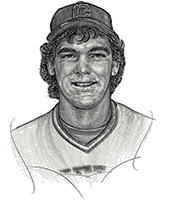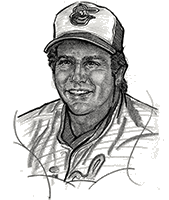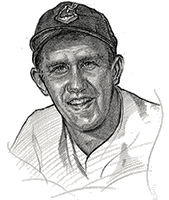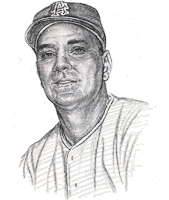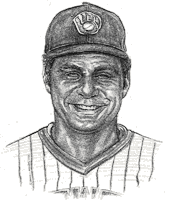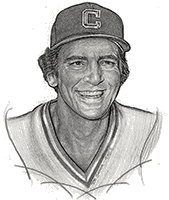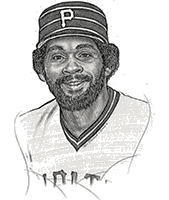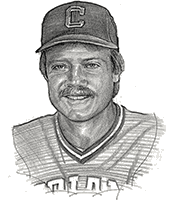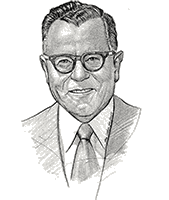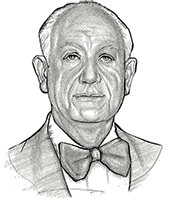Just as Camelot provided the inhabitants of King Arthur’s court with “one brief shining moment,” Charboneau would do the same for long-suffering Cleveland Indians fans some 14 centuries later. The carefree native of Belvidere, IL, burst upon an unsuspecting major league scene in 1980, two years after being traded to the Indians by the Philadelphia Phillies in a minor league deal. With spring training injuries opening the door, he found himself in the Tribe’s starting lineup on April 11 and proceeded to hit-and hit-and hit. By season’s end he had built a .289 batting average with 23 home runs and 87 runs batted in and found he had been named the American League’s “Rookie of the Year.” But there were other sides to the irrepressible rookie’s talents which kept the town buzzing, the turnstiles humming and inspired the inexplicably popular song hit “Go Joe Charboneau” which soared to #3 on the local charts. Such as his penchant for dying his hair grotesquely unnatural colors, opening beer bottles with his eye socket and drinking the beer through his nose with a straw, doing his own dental work and reportedly resetting a broken nose with a pair of pliers. It was enough to terrorize every mother of an impressionable youngster, but somehow to know him was to love him. It all came to a crashing end (literally) the following spring when he hurt his back in a headfirst slide during an exhibition game. He was never the same. He underwent two back surgeries, played in 60 more major league games and was released in 1983. But the mutual love affair with Cleveland prompted him to continue making his home in the area while staying active in various baseball-related activities and he now makes his home in North Ridgeville.
Raised in South Euclid, he became an all-state baseball pitcher at Brush High in 1965, then matriculated at Kent State where he teamed with catcher Thurman Munson to form what might have been the most impressive battery in Ohio collegiate history. Signed with the San Francisco Giants in 1969 and began his major league career with them in 1971. After two years with the Giants and six years split between the Chicago White Sox and Chicago Cubs, he was traded to Baltimore in 1979 and pitched for them in the World Series that year. He reached his zenith the following season, when he became the American League’s Cy Young Award winner after putting together a 25-7 record and pitching in the All-Star game. Turned to broadcasting after the 1981 season and was in his 18th season of doing the Chicago Cubs play-by-play on WGN-Radio at the time of his induction, teaming up with the legendary Harry Caray for the first 15 of those years.
Born and raised on Cleveland’s near East Side, he wrote an admirable story of perseverance as he scratched his way through nine noteworthy minor league baseball seasons in search of a cherished berth on his hometown team, the Cleveland Indians, only to be thwarted by a career ending injury with his goal in sight. Unable to play high school baseball, he signed with the Indians in 1953 and began a minor league odyssey that took him to the Green Bay Blue Jays, the Fargo-Moorhead Twins, the Keokuk Kernels, the Mobile Bears, the Reading Indians, on to San Diego, where he was to earn a spot in their Hall of Fame and Toronto (both then minor league franchises), Mobile, and Salt Lake City. En route, he was named to four league all-star teams, set an Eastern League record with 11 consecutive hits, and twice went to spring training with the Indians. The dream ended in 1961 with a collision between his shoulder and a wall during a second stint with Mobile. He returned to Cleveland, where he worked with Klein News until his retirement. A long-time resident of Seven Hills.
One of Cleveland West High’s finest athletes, he led the Cowboys to the 1952 City High School Baseball Championship Game, only to lose the title clash in an 11-inning duel at Municipal Stadium. However, better days on the Stadium mound were ahead. The most memorable of those appearances came exactly a wearing a Los Angeles uniform as the staring pitcher for the American League in the 1963 Major League All-Star Game. That was his fourth and final appearance as an All-Star, all for the Angels with whom he set a team mark in 1962 with 10 consecutive victories and also compiled a string of 27 consecutive scoreless innings as a staring pitcher. His major league career, begun with the Chicago White Sox AL Championship team in 1959, ended with a shoulder injury prior to the 1964 campaign After several seasons as a minor league coach and manager he joined the Milwaukee Brewers as pitching coach in 1975, but retired in 1976 to take on his current position as president and chief operating officer of a Cleveland-based construction business.
Cleveland-born and raised, he parlayed a solid athletic career at Warrensville Heights High and a series of strong summer performances for highly respected sandlot teams into a baseball scholarship at perennial baseball power Arizona State. When he was named the MVP of the 1965 College World Series, won by ASU, the door was opened to one of the finest major league careers ever enjoyed by a Greater Cleveland native. Drafted by the Kansas City Athletics prior to their move to Oakland, he enjoyed 11 seasons as the A’s third basemen, playing a major role in the team’s three consecutive World Championships in 1972-73-74, playing on four American League All-Star teams and compiling career statistics which still rank him in the A’s top three in six categories. He went on to play five seasons with the Milwaukee Brewers, retiring at the end of the team’s pennant-winning season in 1981. Subsequently he became a special assistant to the Brewers general manager, was promoted to general manager in October, 1991, and held down that position for eight seasons. He remains active in Milwaukee community affairs and makes his home in Mequon, WI.
Deceased 2023
Joe Nossek spent 43 years in professional baseball, 37 of them in a major league uniform. No native Clevelander had ever matched those numbers when he hung up his Chicago White Sox uniform for the final time in the spring of 2004 to retire with his wife, Jean, to their home in Amherst. His lengthy list of baseball honors began accumulating early. He earned first team All-Ohio laurels as a senior at Euclid High in 1958, after which he was signed from Ohio University as an amateur free agent by the Minnesota Twins in 1961 after winning first team All-American and All-Mid-American Conference recognition. He joined the Twins as an outfielder in 1964, beginning a six-year career which included stops at Kansas City/Oakland and St. Louis, including the realization of the dream of every player when he appeared in six games of the 1965 World Series with the Twins. When his playing days ended, he spent two years as a minor league coach and manager, then joined the Milwaukee Brewers as their third base coach in 1972, launching the long final phase of his career in which he established himself as one of the most astute coaches in the game and perhaps baseball’s finest sign stealer. His tour on the coaching sidelines included five years back home as the Indians’ third base coach and culminated with a 20-year stint from 1983 through 2003 in Chicago, the last 13 as the White Sox bench coach.
An early round selection of the Houston Astros in the 1969 amateur players draft after a stellar baseball career at Benedictine High, Mike Easler trod the border line of a major league career for 10 long years before finally locking down a big league berth with the Pittsburgh Pirates’ 1979 World Championship team as a pinch hitter. After hitting a career high .338 with 21 home runs in 1980, he found himself realizing a dream by playing before his family in the 1981 All-Star Game at Municipal Stadium. By the time he ended his playing career after the 1987 season he had established himself as one of the game’s most respected hitters with a .293 career average over 1,151 games played with six teams—the Astros, Angels, Pirates, Red Sox, Yankees and Phillies—over a 14 year span. Among his career highlights: hitting for the cycle as a Pirate in 1980 in a 10-6 win over the Reds; finishing in the American League’s Top 10 in hitting (.313), hits (188) and slugging percentage with the Red Sox in 1984; and notching an eighth inning single as a Yankee for the only hit off the Indians’ Tom Candiotti in a 1987 contest. He later served as batting coach for the Red Sox and Cardinals and at the time of his induction was with the Cincinnati Reds organization for which he has served in several managing and coaching positions both in the United States and Latin America. He makes his home in Las Vegas.
On May 15, 1981 Lenny Barker carved a special niche for himself in the history of Cleveland Indians baseball by pitching the 12th perfect game in major league history, handcuffing Toronto 3-0, striking out 11 Blue Jays along the way. It was, however, far from the only highlight of his four-plus seasons with the Tribe. Twice in that period (1980 and 1981) he led American League pitchers in strikeouts and was second in 1982. He was named to the 1981 AL All-Star team, which was played in Cleveland, and pitched two hitless innings before an appreciative crowd of 72,086. His 56-49 record with the Indians included 19-12 (1980) and 15-11 (1982) seasons and earned him a place on the roster of the 100 Greatest Indians named in 2001 as part of the team’s 100th Anniversary celebration. His seasons with Cleveland were the finest of an 11-year major league career in which he won 74 games. Now in the construction business, the native of Ft. Knox, KY and star high school athlete at Neshaminy High School in Trevose, PA makes his home in Auburn Township.
A major figure in the development of amateur baseball in Cleveland, he served as president of the Cleveland Baseball Federation from 1960 to 1976. Served as a member of the board of the Federation from 1948 until 1960 and chaired the Class “F” baseball program for youngsters for 12 years. Also served as a member of the Ohio Racing Commission for 12 years and was named “Man of the Year in Ohio Racing” in 1967.
Treasurer of the Cleveland Baseball Federation for over 50 years, he was responsible for raising hundreds of thousands of dollars to equip youngsters to play sandlot baseball in Cleveland and to cover their medical expenses. His promotion of the annual Sandlot Day exhibition baseball game played annually by the Cleveland Indians beginning in 1948 was the cornerstone on which his successful fund-raising efforts rested.
2001 Crocker Rd., Ste. 510, Westlake, OH 44145
Phone: 216-241-1919

